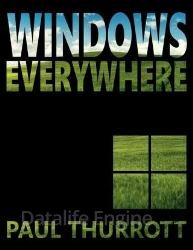 Название: Windows Everywhere : The rise and fall of the most important software platform of all time
Название: Windows Everywhere : The rise and fall of the most important software platform of all timeАвтор: Paul Thurrott, Rafael Rivera
Издательство: Leanpub
Год: 2023-03-19
Страниц: 938
Язык: английский
Формат: pdf (true)
Размер: 139.7 MB
This is the story of Microsoft Windows, but told in a different way and from a different perspective. It is the story of the aspirations that Microsoft had for the platform over time. Object-Oriented Programming in the era of “Cairo.” The brief moment when the .NET craze engulfed the company. The touch-first mania of Windows 8. And so much more.
The history of Windows can be seen as a series of reactions to competitors, market trends, and internal forces that were seeking change. Along the way, Microsoft worked to improve and adapt Windows to an incredible variety of new uses cases, form factors, and competition. From a milestone perspective, most normally think of the history of Windows as a series of product version releases starting in 1985. That history is well-documented, I think, but since it’s important to our alternate history of application development technologies, it’s perhaps worth considering briefly.
Microsoft dragged its developer base into a losing battle against open source and open standards that lasted for decades. And yet, despite its recent and thorough embrace of openness, Microsoft continues to provide new proprietary solutions to its developers and customers alongside its more open offerings, especially in Windows and other legacy products. Doing so seems like an unnecessary delay to the inevitable shift that has happened elsewhere in the company and in the broader industry. I think of this history in terms of inflection points, of how Microsoft reacted to what was happening elsewhere in the industry. From its start, Windows itself was a reaction to the Graphical User Interface (GUI) and so-called WIMP (“windows, icons, menus, pointer”) user experience. This type of interaction was invented in research labs in the late 1970s, and it was first brought to the mainstream consumer market by Apple. But it was popularized, of course, by Windows, which Microsoft created as a hedge to ensure that its platforms, and not those made by Apple, IBM, or others, would continue to dominate.
The next inflection point was the rise of UNIX, arguably the first major open platform (though, yes, that only occurred over time). Microsoft’s reaction to this platform was to create a platform-agnostic UNIX killer, originally called NT and built by a skunkworks team hired away from Digital Equipment Corporation (DEC). NT allowed Microsoft to sever its ugly relationship with IBM, again ensuring that its platforms, not others, would continue to dominate.
When the World Wide Web (WWW) happened without its participation in the mid-1990s, Microsoft was slow to react. But then Netscape’s Marc Andreessen, still in his early 20s, was declared the next Bill Gates. And when he uttered his infamous and prophetic assessment that the web browser would become, in effect, the real operating system while Windows would be relegated to little more than “poorly debugged set of device drivers,” Gates and Microsoft finally woke up.
Microsoft could have learned from the mistakes of this era, could have led its developer and customers down a path in which proprietary Windows and Microsoft-only solutions gave way to open standards and systems. But it instead continued down the same proprietary path as in the past. In fact, its next major platform, called .NET, was born out of a desire to embrace the best of the web and open standards—XML, SOAP, and so on—and extend them via a proprietary platform that ran only on Windows, on both the client and server.
Where Apple and Google race forward to embrace new technologies, Microsoft spends most of its time supporting technologies that it created years or decades ago, and no developer is left behind. The Windows App SDK, for example, can be seen as a long-overdue path forward for both Win32 and UWP developers, and that’s good on one level. But this kind of inclusivity, while admirable, can also be seen as a dead weight around Windows and its users and is the real reason we’re all still stuck in “Win32 hell,” where the only applications its users want are legacy applications built on legacy technologies. Microsoft’s inability to move forward has hurt us all, and the failures of incompatible platforms like Windows Phone/Mobile, Windows RT, Windows 10 S Mode, and Windows on ARM only serve to emphasize this point.
Contents:
Скачать Windows Everywhere : The rise and fall of the most important software platform of all time
[related-news] [/related-news]
Комментарии 0
Комментариев пока нет. Стань первым!
















